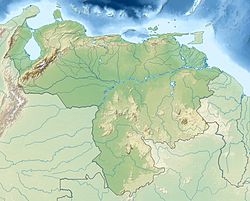Top Qs
Timeline
Chat
Perspective
Río Cachirí Group
Geological group in the Venezuelan Andes From Wikipedia, the free encyclopedia
Remove ads
The Río Cachirí Group (Spanish: Grupo Río Cachirí, PZc) is a geological group of the Cesar-Ranchería Basin, Colombia and the Serranía del Perijá of the northernmost Colombian and Venezuelan Andes. The group of shales, sandstones and limestones is of Devonian age and has a maximum thickness in the Venezuelan section of 2,438 metres (7,999 ft). The group contains abundant fauna; crinoids, bryozoa, brachiopods and molluscs have been found in the group.
Remove ads
Remove ads
Etymology and definition
The formation was defined by Liddle in 1928 in Río Cachirí, part of Mara, Zulia, in the Venezuelan part of the Serranía del Perijá, and the same author subdivided the group into three formations in 1943. In 1972, Bowen added a fourth formation to the group.[1]
Description
Summarize
Perspective
Lithologies
The group contains black, grey and red shales, grey micaceous sandstones, quartzitic sandstones and red and bluish grey limestones.[1]
Stratigraphy and correlation
The Río Cachirí Group, dated to span the Devonian, is subdivided into the Caño Grande, Caño del Oeste, Campo Chico and Los Guineos Formations. The maximum thickness has been recorded in Venezuela, with 2,438 metres (7,999 ft), while the thickness on the Colombian side of the range does not exceed 1,100 metres (3,600 ft).[1] The group is recognised along a section of approximately 110 kilometres (68 mi) in the Venezuelan terrain.[2] The group unconformably overlies the Perijá Formation and is overlain by an unnamed Carboniferous sequence. The Río Cachirí Group is time-equivalent with the Floresta and Cuche Formations of the Floresta Massif, Altiplano Cundiboyacense and the Quetame Group of the Eastern Ranges.[3] The sediments of the Río Cachirí Group were deposited in an epicontinental sea at the edge of the Paleo-Tethys Ocean.[1]
Fossil content
The group contains abundant fossils of crinoids, bryozoa, brachiopods and molluscs as Acrospirifer olssoni, Spirifer kingi, Leptaena boyaca, Fenestella venezuelansis, Neospirifer latus, Composita subtilita, Phricodrotis planoconvexa and Pecten sp.[4]
Remove ads
Outcrops
Apart from its type locality on the eastern flank of the Serranía del Perijá in Zulia, Venezuela, the formation is also found in other parts of the mountain range, on the Colombian western side in the east of San Diego and Curumaní, Cesar.[5][6]
Regional correlations
- Legend
- group
- important formation
- fossiliferous formation
- minor formation
- (age in Ma)
- proximal Llanos (Medina)[note 1]
- distal Llanos (Saltarin 1A well)[note 2]
Remove ads
See also
Notes
References
Wikiwand - on
Seamless Wikipedia browsing. On steroids.
Remove ads



























